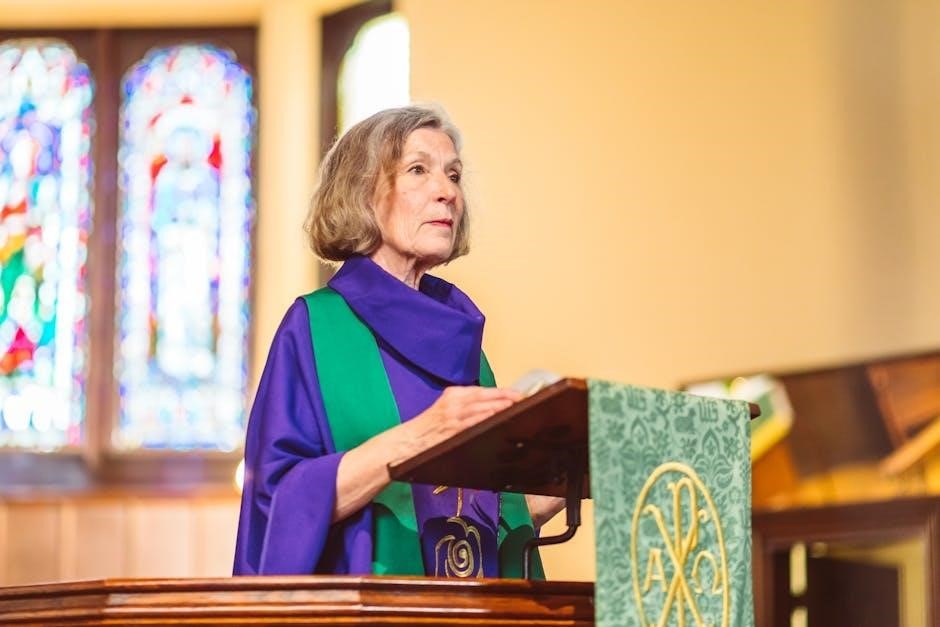
palm sunday sermon outline pdf
Palm Sunday commemorates Jesus’ triumphal entry into Jerusalem, marking the beginning of Holy Week. The crowd waved palm branches, symbolizing victory and peace, but their expectations of a political savior clashed with Jesus’ true mission of spiritual salvation. Riding a donkey, Jesus fulfilled Zechariah’s prophecy, embodying humility and kingship. This event, recorded in the Gospels, highlights the tension between celebration and impending crucifixion, inviting reflection on Jesus’ identity and purpose.

The Crowd’s Expectations vs. Jesus’ Mission
The triumphal entry of Jesus into Jerusalem, as celebrated on Palm Sunday, reveals a stark contrast between the crowd’s expectations and Jesus’ true mission. The crowd, having heard of Jesus’ miracles and teachings, eagerly anticipated a political savior who would liberate Israel from Roman oppression. They waved palm branches, shouting “Hosanna!” and “Blessed is he who comes in the name of the Lord!” (John 12:13). This joyful reception reflected their hope for a mighty king who would restore Israel’s glory and establish an earthly kingdom.
However, Jesus’ actions and words during this event revealed a different purpose. Instead of riding a majestic warhorse, He entered Jerusalem on a humble donkey, fulfilling Zechariah’s prophecy: “Behold, your king is coming to you; righteous and having salvation, lowly and riding on a donkey” (Zechariah 9:9). This symbolic act emphasized His mission of peace, humility, and spiritual salvation, not military conquest or political power.

The crowd’s expectations were deeply rooted in their understanding of Old Testament prophecies, but they often misunderstood the nature of the Messiah’s kingdom. While they sought a deliverer from Roman rule, Jesus’ mission was to save humanity from sin and establish a spiritual kingdom. This misunderstanding would eventually lead to disappointment and conflict, as the crowd’s hopes for an earthly savior were not fulfilled.
This tension between the crowd’s expectations and Jesus’ mission serves as a reminder of the deeper spiritual truths of Holy Week. Jesus did not come to satisfy earthly ambitions but to offer redemption and eternal life. His entry into Jerusalem marked the beginning of a week that would culminate in His crucifixion and resurrection, the ultimate expression of His divine purpose.
In reflecting on this contrast, we are invited to examine our own expectations of Jesus and His kingdom. Like the crowd, we may seek immediate solutions to our problems or earthly successes, but Jesus’ mission calls us to look beyond the temporal to the eternal. His triumphal entry into Jerusalem was not a celebration of power but a declaration of love and sacrifice, reshaping the world’s understanding of what it means to be a king.

The Symbolism of the Donkey
The donkey Jesus rode into Jerusalem on Palm Sunday holds profound symbolic meaning, reflecting His mission and character. In biblical tradition, donkeys were associated with humility, peace, and servant leadership, contrasting sharply with the majestic warhorses typically ridden by kings and conquerors. By choosing a donkey, Jesus fulfilled Zechariah’s prophecy: “Behold, your king is coming to you; he is just and having salvation, lowly and riding on a donkey” (Zechariah 9:9). This act emphasized His identity as a humble servant-king, not a mighty warrior.
The donkey also symbolized accessibility and approachability. Unlike a horse, which was often reserved for the elite, a donkey was a common animal, used by ordinary people for transportation. Jesus’ choice of a donkey underscored His connection to the marginalized and His commitment to bringing salvation to all. It was a powerful declaration of His kingdom’s values: humility, compassion, and inclusivity.
Furthermore, the donkey represented peace. In contrast to the conquests of earthly rulers, who often entered cities on horses to signify their military power, Jesus entered Jerusalem on a donkey to proclaim His reign of peace. This symbolic gesture aligned with His teachings of love and forgiveness, highlighting His mission to bring spiritual reconciliation rather than earthly domination.
The donkey’s symbolism is deeply intertwined with the themes of Holy Week. While the crowd celebrated Jesus as a conqueror, His humble entry foreshadowed the sacrifice He would make on the cross. The donkey became a visual reminder of His willingness to submit to God’s plan, even in the face of rejection and death.
In reflecting on the donkey’s symbolism, we are invited to embrace humility and trust in God’s plan. Just as the donkey carried Jesus into Jerusalem, we are called to bear the message of His love and peace to a world in need. The donkey’s simplicity and gentle nature challenge us to live with humility and compassion, following Jesus’ example.

Mixed Reactions to Jesus

The triumphal entry of Jesus into Jerusalem on Palm Sunday was met with a mix of excitement, curiosity, and skepticism. While the crowd rejoiced, waving palm branches and shouting “Hosanna,” not everyone shared the same enthusiasm. The event exposed the deep divisions among the people and the religious leaders regarding Jesus’ identity and mission.
The crowd’s reaction was largely driven by their desire for a political savior. They had heard of Jesus’ miracles, such as turning water into wine, healing the paralytic, and raising Lazarus from the dead, and they hoped He would overthrow Roman rule and restore Israel’s independence. Their chants of “Hosanna” and “Blessed is he who comes in the name of the Lord” reflected their expectation of a mighty deliverer. However, their understanding of Jesus’ mission was incomplete, as they focused on earthly liberation rather than spiritual salvation.
On the other hand, the religious leaders viewed Jesus with suspicion and hostility. The Pharisees and Sadducees saw Him as a threat to their authority and the traditions of Judaism; They were dismayed by His popularity and feared His influence could lead to unrest and Roman intervention. Their opposition to Jesus was evident in their questioning of His actions and their eventual plot to crucify Him.
Even among Jesus’ followers, there was a mix of emotions. The disciples were caught between their excitement at being part of a historic moment and their confusion about Jesus’ true purpose. While they believed in Him, they struggled to understand His emphasis on humility and sacrifice over power and glory.

The mixed reactions to Jesus on Palm Sunday serve as a reminder of the complexity of human response to God’s revelation. While some embraced Him with hope and joy, others rejected Him out of fear or misunderstanding. This dynamic continues to resonate today, as people grapple with who Jesus is and what He represents.

The Victory of Jesus
The triumphal entry of Jesus into Jerusalem on Palm Sunday is a powerful symbol of His victory, not through military might or political power, but through humility, love, and sacrifice. Jesus’ deliberate choice to ride into the city on a donkey, rather than a warhorse, fulfilled Zechariah’s prophecy (Zechariah 9:9) and demonstrated His mission of peace and salvation. The crowds, unaware of the deeper significance of this act, celebrated Him as a conquering king, waving palm branches and shouting “Hosanna!” Yet, this moment of triumph was not an end in itself but a step toward the ultimate victory achieved through His crucifixion and resurrection.
Jesus’ victory is rooted in His unwavering commitment to God’s plan. Despite knowing the suffering that lay ahead, He entered Jerusalem willingly, embracing the path of sacrifice. His tears over the city (Luke 19:41-44) revealed His deep love for the people and His sorrow over their spiritual blindness. This act of humility and obedience foreshadowed the victory He would achieve on the cross, where He conquered sin and death, offering salvation to all humanity.

The victory of Jesus is not limited to a single event but is eternal and universal. His reign as King extends beyond earthly kingdoms to the hearts of believers worldwide. On Palm Sunday, we are reminded that true victory is found in surrender, love, and redemption, not in worldly power or glory. As Easter people, we celebrate the triumph of Jesus, knowing that His victory is our hope and strength in the face of life’s challenges. This day invites us to reflect on the transformative power of His love and to align our lives with His mission of peace and reconciliation.